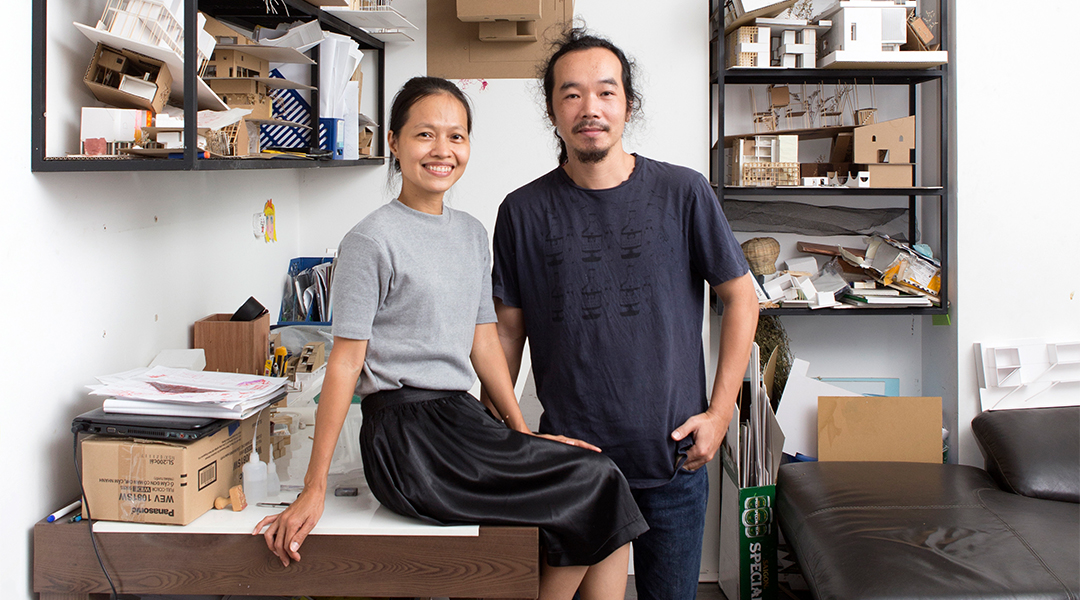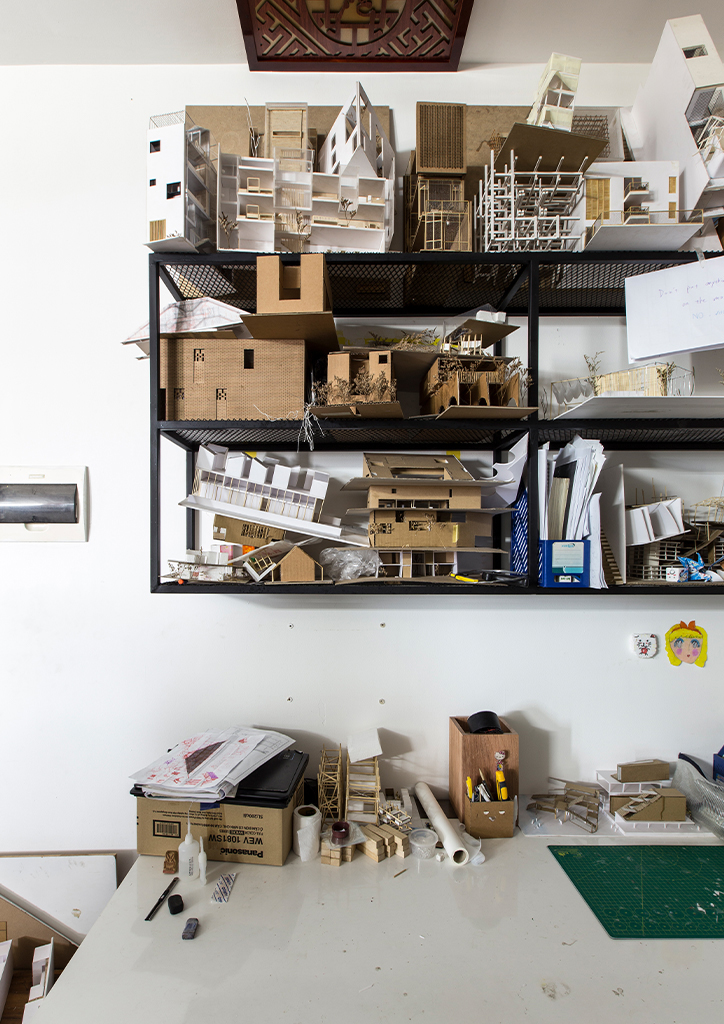
Building Blocks: Tropical Space’s distinct brick vernacular
We asked Tropical Space the question many observers of their work wanted to pose: why the love for bricks? Studio co-founder and principal Tran Thi Ngu Ngon gives one of her frequent smiles and answers with what she often says to many, but for the record, “It simply works in our climate,” she says. “It is a material that adapts with the hot and cool of the tropical region. Its economical, modular form makes it easy to work with, and it’s easily sourced here in Vietnam; its textures and color grant our architecture a natural character.”
It is this pragmatic approach to materiality that pervades the studio’s small but growing portfolio, one given a distinctly local twist with their playful formal experimentations of locally available materials. The clay red brick, their current favorite, is actually a traditional Vietnamese material that is still manufactured aplenty throughout the country. Its local history can be traced back to the brick temples of the Champa, an Indic civilization that flourished in central and south Vietnam, back in the 13th century. To this day, each region of Vietnam produces its own varieties and interpretations of this material in response to cultural context and climate, one Tropical Space is keen to explore.
Laying the foundations
Tropical Space started with the husband and wife duo of Nguyen Hai Long and Tran Thi Ngu Ngon abandoning their previous architecture jobs seven years ago to start their own company. The studio name carries the crux of the duo’s mission vision, which is to create beautiful modern homes in Vietnam that work with the tropical climate, providing their clients with comfortable living spaces. Starting from sharing a small space with another architect friend for their office, the couple eventually purchased a flat in Ho Chi Minh City which serves as both their home and office, a boon for the couple who balances household chores, rearing their two kids, and running their now ten-man strong operation. When asked about how they run the company, Ngon beams, “We’re really like an extended family; I consider my employees like younger brothers and sisters. We work together, eat together, or sometimes spend afternoons just drawing.”

Brick love
The love for clay brick grew soon enough after the firm’s establishment. “We began using bricks on a few of our projects in small portions, but then we started noticing its admirable, functional qualities and began to use it in larger areas and with more frequency,” Ngon says. This eventually climaxed into their first, all-brick project, the multi-award-winning Termitary House in Da Nang, Vietnam. Its memorable perforated cube shape houses a spatial configuration that was influenced by the inner workings of a termite’s nest. “We love to find inspiration in nature; we admire the interiors and dim lighting of caves, the hulking forms of the mountains, or even the dappled lighting of trees,” co-founder Nguyen Hai Long adds.
Beyond the brief
“We like to joke when we are asked about our design process,” Ngon grins. “After we interview a prospective client, we forget the brief altogether and offer them something else!” she laughs. While this may sound alarming, what Tropical Space actually intends is to go beyond what the client wants (with basic requirements in mind, naturally) and offer them something they think will ultimately be more beneficial to them. “I remember having this client who wanted to open a café in Da Nang,” Ngon recalls. “But Vietnam is already riddled with too many coffee shops. I told him: “I don’t want to design a coffee shop. Let’s design an art gallery with a café instead!” The client was eventually convinced. When asked whether they’ve said no to clients, Ngon responds that she rarely refuses a project, trusting the possibility that should the client err in judgment and taste, they can convince them to play on their side.
Small talk
The firm’s size limits the number of projects they can take on in a year, but Ngon and Long are dismissive when it comes to how many projects they are designing. Quality over quantity is the dictum they abide by. “At the end of the day, the number of projects we get is not important. I think even having just one project is good enough, as long as it’s done well. One’s proficiency is often judged not by the number of things you know how to do but how well you do a certain thing,” Long says. The studio’s lean numbers do not, however, stop the team from submitting different proposals for a client to pick from. “I often get asked by my staff why I decide to send so many proposals for a client to select when they just ask for one or two,” Ngon says. “I love to come up with new ideas and solutions and can’t help but create more options than necessary. I think this exercise of crafting numerous design studies is also beneficial to my staff and their portfolios; it helps develop and deepen their understanding of the field, to be more experimental, and enriches their experience of the craft.”
Passing the torch
Like many of Vietnam’s burgeoning architectural practices, Tropical Space sees value in staying small and compact as a team, which Ngon says helps them maintain the quality of their projects. The need for extra hands, as well as an innate desire to broaden the reach of their mission, however, has led the co-founders to consider taking in interns. This proved to be an eye-opening experience for Ngon, who from the beginning didn’t see a need for it. “Our first-ever intern was a Vietnamese student born in Canada. I took her in because she loved our work and spoke Vietnamese. But more than just her learning from us, we also learned a lot from her as well.” This prompted the couple to open the studio to interested interns, which they limit to two to three a year. During our visit, they were mentoring a Japanese architecture student, Kota Sakurada. “What I liked about this studio is they really helped me discover what I want to do as an architect,” Kota says of his mentors. “They didn’t push me to do things their way but helped me develop and recognize what approach it is that I want to inform my brand of architecture,” he adds.
When asked about employees leaving the studio to form their own practices, Tropical Space’s amiable founders welcome it. “We will be happy and proud of them. We’d like to think that we make beautiful buildings and we hope that Vietnam is blessed with more of them through what our employees have learned from their stay here,” Ngon says. “We want to groom and train the next generation of Tropical Space, architects who carry our principles and philosophy in their work. Ngon and I can’t do it alone,” Long adds.

Digital fame
The world’s window to the exciting Vietnamese architectural landscape is online. Social media and architecture websites like Dezeen and ArchDaily fawn over Vietnamese projects with regularity. When asked why this is so, Ngon attributes this to the innate resourcefulness of the Vietnamese as a race, “Europe, America, and other rich countries can afford to create good and amazing architecture with plentiful resources. In Vietnam, where things aren’t as abundant, and the government isn’t as supportive of local talent, we make do with what we have and strive to form exciting and unexpected things with what little resources we have,” she says. “I think this desire to achieve and surprise with scarce resources is what makes Vietnamese architecture exciting to watch.”
Having a prevalent and frequent online presence, however, is a double-edged sword, especially when clients are concerned. Ngon says that most of their clients first find their work online. However, this wealth of information online has, in a way, encouraged a propensity for local clients to treat their house’s architecture like fashion, thinking façades can be worn and discarded when out of vogue. As a result, there are a lot of me-too homes and costly renovations done in the name of keeping up with what’s on-trend. Ngon even shares that some clients think that they don’t need an architect when they can refer to their mood boards online.

Bricks and beyond
Tropical Space’s distinct brick vernacular has gained its share of admirers and has been successful in scooping architectural awards worldwide. As of writing, the studio has recently garnered the 2018 Wienerberger Brick Award for Terra Cotta Studio in Quang Nam province, their second accolade from the award-giving body, and the lone Asian entry. “The role of awards for us is that it gives us affirmation and confidence to keep doing what we’re doing,” says Ngon. “It also connects us with new people and gains new friends around the world.”
When asked whether they consider their copious use of brick as their style or characteristic of a signature aesthetic, Ngon responds, “We’re always open to working with other materials in our projects,” she pauses. “But I think we’re enamored and having too much fun with the possibilities clay bricks can still offer. I think we’ll keep working with it until we’ve exhausted its full potential.”
This article was first published in BluPrint Volume 3 2018. Edits were made for BluPrint online.
Photographed by Ed Simon
READ MORE: Tropical Space’s Terra Cotta Studio wins Wienerberger Brick Award


